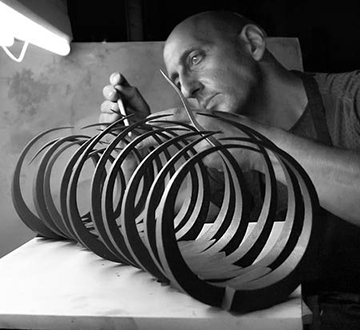Alberto Bustos′ ceramic creations are famous for their abstract lines and coloring compounded with a conceptualized sense of space. With his extraordinary skills, he makes the porcelain slender and versatile and then combines them into three-dimensional forms to convey his feelings. Sometimes the ceramics are submissive, like grass in the wind, sometimes like insolent fiery eruptions, and sometimes resembling the choppy sea. Because of this unyielding creativity, his artworks in the modern art world truly stand out.
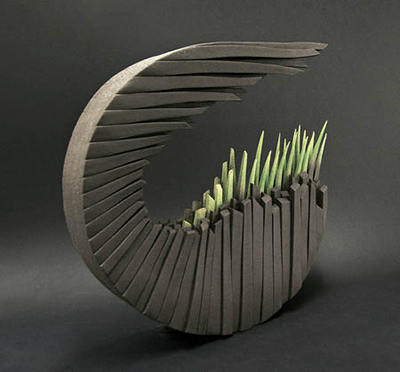
Alberto′s works have no fixed form, nor do they possess a beginning or an ending. His art is an amalgam of feelings and representations, reminiscent of our real life. On the one hand, his work signals the general anxiety among modern people. On the other hand, it depicts the courage of modern people to fight for freedom. There is no ″absolute″in his creations either. One can see hope in frustration, calm in struggles as well as green color in a white whole. According to Alberto, he tends to provide an ″exit″ in his art, giving people a sense of hope. At this point in history, when everyone is restricted by the epidemic, this sense of hope is even more urgent.
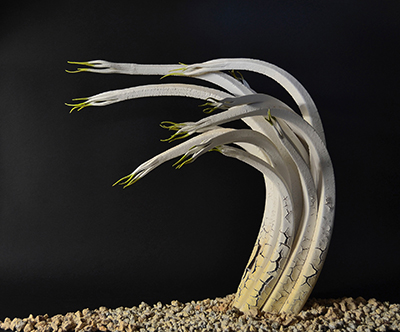
Alberto did not receive formal training in ceramics. He relies on his hands and innate acuity to describe his feelings. He repeatedly beats the clay to create various lines and then uses surreal techniques to create a visual representation that firmly draws in the viewer. This is evident when it comes to his creating natural space, the flow of air, the swaying branches, which clearly express his desire for nature. He also uses ceramics to cry against an unjust society. His unique technique deeply touches the public. In recent years, the workshops he held have been well received in all regions in the world.
We are honored to interview Alberto and hope that you will learn more about his sculptural methods and ideas.
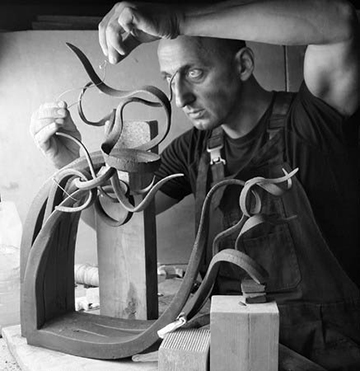
Q: Your ceramics are truly unique. They stem from your heart and soul. Please share with us your experiences that led you to the path of ceramics.
A: From a very young age I had artistic concerns. I remember that I did not play with the toys that my parents gave me. I preferred to make my toys myself.
In the art world, although in an amateur way, I started painting. Soon two dimensions were not enough to show my feelings. I needed volume. To work the volume I thought that the easiest thing would be to work with clay. Open a package, take out a piece, and start modeling. After more than 25 years working with clay, I keep learning since its techniques and variations are endless.
I also worked with other materials such as wood, bronze, etc. Today I can say from my experience that clay is the most complicated modeling material I have ever worked with. The whole process is very laborious and fragile, finally, it is the kiln that decides the final result. In that step, we can do nothing. Is magic!

Q: If you don′t mind, please share with us the techniques that enable you to make ceramics so thin and delicate.
A: First, I draw sketches on paper, a basic idea that is later developed directly in stoneware or porcelain. I am essentially self-taught, for this reason, I learned to work mainly with my hands without modeling tools. I make filaments with my ″launch″technique. I start by picking up small pieces of clay and hitting them repeatedly on a wooden slab, I get their peculiar shapes that are reminiscent of vegetation. On my website, www.albertobustos.es, you can see different videos that show my technique. I work different types of filaments; square, flat, rectangular, etc. I usually apply coloring pigments mixed with glaze directly on the wet clay. This way I usually only do one firing. Then I assemble them directly on the kiln plate to avoid directly touching the piece when putting it in the kiln. I also make many experimental pieces using bases, cardboard, sponges, aluminum foil, wax paper, etc. All these materials mixed with different types of clay and glazes.
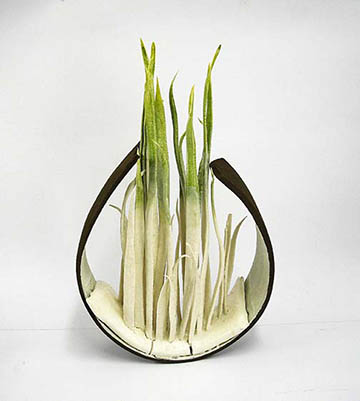
Q: The natural landscape is an important theme in your work. How do you inscribe nature into your creation?
A: I was born in a city (Valladolid-Spain) with very little nature. Without the sea, without mountains, without forests… I think it negatively influenced my growth. I always felt that I needed nature to feel better. Many people think that my sculptures reproduce vegetal elements and it is not true. Each piece tells a moment of my life. I always show the lack of oxygen and light that I felt in my city. Normally, in every sculpture there is hope. Perhaps a single filament that manages to have a color or that finds an exit… It′s me! Fortunately, I have lived in a town near the sea in Catalonia for three years. I also have mountains and forests nearby. It is very good for me.
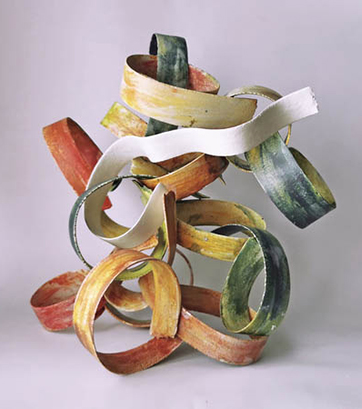
Q: You have taken a nonconformist approach to your work. Will you elaborate on this?
A: I use clay to transmit messages; personal messages, as I said earlier, but also messages about the injustices that surround us. From a human point of view and also on the degradation of the natural environment. I think art is a great tool to question the injustices that surround us.
Q: You also design jewelry. Please tell us more about your jewelry designs, the materials used, and the styles employed.
A: I don′t usually work jewelry. With the confinement of these last months [due to COVID-19], I tried to make a series of necklaces reproducing shapes similar to those of my sculptures. The name of this series says it clearly, ″sometimes I DO it″ The economy is very worrying at the moment and I have wanted to work these necklaces so that people who want to have something of mine can buy it at cheaper prices. This first series consists of 10 necklaces made in white porcelain with matte glaze. I plan to do another series with black porcelain also with matte glaze.
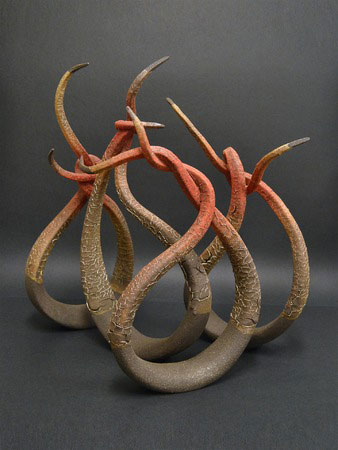
Q: What steps are involved in creating your ceramic sculptures? When do you consider a piece finished?
A: First there is the idea that is generated in my mind. I usually use the night hours, when everything stops, to visualize the new sculpture. Later I usually develop it on paper, the sketch, but not always. On many occasions the idea jumps directly from my mind to the clay package. Modeling is faster than people think, since the elements I work with are very fine and dry quickly. This forces me to work very delicately but fast. I usually dry the sculpture in the kiln. It is easier to put it in when it is still a little wet because it is more elastic. If the sculpture is completely dry, it is very dangerous to put it in the kiln because any vibration can break it. After firing, I store them in wooden boxes with multiple supports so that they do not suffer breakage during shipments.
I think a piece is never finished. After leaving the kiln she continues with her life. Just like human beings. Sometimes a sculpture suffers damage. But it is not the end of the sculpture. This fact is part of your life. Let′s imagine that a family member has to have a leg amputated, or he suffers from an illness, should we stop loving him?
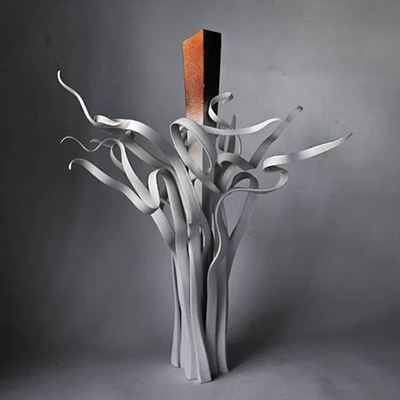
Q: You also conduct workshops worldwide. Please tell us what your workshops entail.
A: I never thought about doing workshops because I am self-taught. I didn′t imagine that I could teach potters who have academic or other training. Finally, many ceramic studies began to ask me if I could do workshops to teach my ″curious″ techniques. I decided to say yes, why not?
For four years I have been traveling all over the world showing my techniques and I have more and more commitments. I currently have three types: the three-day workshop ″Filaments and textures″, the three-day workshop ″Experimental techniques″, and a one-day Master class where I work only showing my techniques for eight hours. In all of them, I not only show my techniques but also through a video presentation I explain my career in ceramics — from my beginnings until today. It is a great experience for me because I also learn a lot from all the potters I know and from the technical variations that each continent has in addition to its cultures, customs, landscapes, languages, etc.
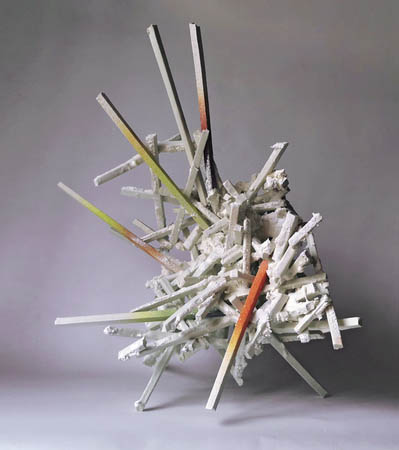
Q: Please tell us about any of your upcoming events.
A: It is difficult to plan now with COVID-19. Many of the workshops I had planned have been postponed. In August I have two Master Classes in Moscow, then workshops in the Czech Republic, Ukraine, Italy, Belgium, Ecuador, Argentina and Switzerland. I also have an exhibition planned in my country. In the three months that I have been unemployed, I have taken the opportunity to make my new website, www.albertobustos.es, where you can see all my upcoming events.
Alberto Bustos
“Freedom, my most refined technique”
